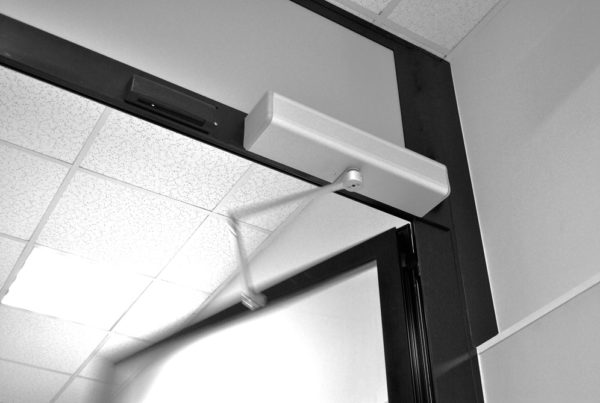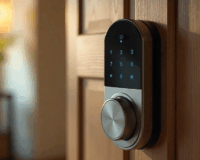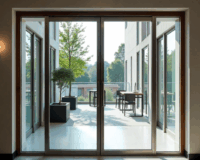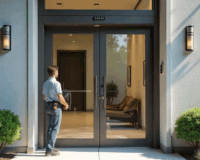In hospitals and clinics, every minute counts. Healthcare workers, patients, and visitors are constantly moving between departments, operating rooms, and treatment areas. In such a busy work environment, the use of traditional doors can create a lot of friction. That is where hospital automatic doors, especially automatic swing door systems, come into play. Using these types of doors eliminates the need for physical contact, reduces the risk of infection, and improves mobility throughout the facility.

What Is a Hospital Automatic Door?
A hospital automatic door is an automated entry system that opens and closes without the need for manual force. Using motion sensors, push plates, or touchless switches, these doors detect people approaching and respond automatically. In healthcare environments, they’re designed to maintain hygiene, comply with accessibility laws, and ensure patient and staff safety.
Automatic doors in hospitals typically include sliding doors, swing doors, and hermetically sealed doors. Among these, automatic swing doors stand out because they combine traditional door function with advanced automation technology. They’re ideal for smaller or specialized spaces such as patient rooms, operating theaters, isolation wards, and administrative corridors.

Understanding Automatic Swing Door Systems
Automatic swing doors look very similar to conventional hinged doors but are powered by an electromechanical or electrohydraulic motor. This motor, often called a door actuator, controls the opening and closing cycle based on data from a sensor or access control system.
When someone approaches, a motion sensor or presence sensor activates the motor. The door opens gently and closes after the person has passed through. The system uses soft start and soft stop technology for smooth, quiet movement, which is especially important in hospitals where noise needs to be kept low.
Automatic swing doors can be single or double leaf, depending on the size of the door. They can open inwards, outwards or both ways. Some are fully automatic, while others operate semi-automatically with minimal push from the user. For hospitals, fully automatic revolving doors are preferred due to their hands-free convenience and superior hygiene performance.

How Automatic Swing Doors Work
The operation of an automatic swing door relies on several key components working together. Sensors or switches first detect motion or a signal to open the door. This can come from an overhead motion sensor, an elbow or foot switch, or an access control device such as a keycard reader. The activation signal triggers the door operator, which powers the motor to swing the door open. Safety sensors on the door leaf and frame ensure that if a person or object is in the way, the door stops or reverses automatically. Once the doorway is clear, the system gently closes the door.
High-quality systems include backup batteries that keep the door functional during power outages, a critical feature in medical facilities. The door’s control panel allows facility managers to set modes such as automatic, manual, hold-open, or lock-down depending on time of day or operational requirements. The system’s design ensures constant reliability and safety, even under heavy use.

Why Hospitals Need Automatic Swing Door Solutions
Automatic swing door systems offer far more than convenience. They address the key challenges faced by healthcare environments—hygiene, accessibility, and efficiency—while meeting international safety and building standards.

Infection Control and Hygiene
One of the biggest threats in hospitals is cross-contamination. Door handles and push panels are the most frequently touched surfaces, making them hotbeds for germs and bacteria. Automatic revolving doors completely eliminate the need for physical contact when moving. When combined with touchless activation sensors or hand-wave switches, they help maintain sterile conditions in operating rooms, isolation areas, and intensive care units. Some models even have antimicrobial coatings or airtight edges to prevent the spread of bacteria.
Accessibility for All Users
Hospitals must be accessible to everyone, including patients using wheelchairs, stretchers, or mobility devices. Automatic revolving doors comply with ADA (Americans with Disabilities Act) and EN 16005 standards, ensuring smooth and safe door opening for users of all abilities. Adjustable opening speeds and extended hold times allow staff and patients to move through comfortably without rushing.
Improved Staff Workflow
Hospital staff need to move quickly, often carrying medical instruments, equipment, or patient records. Manually opening doors every few seconds can slow them down and add to their stress. Automatic revolving doors allow for quick entry and exit, allowing for seamless movement and improved workflow efficiency. This reduction in physical contact also means fewer interruptions in a sterile environment and smoother workflow in the event of an emergency.
Energy Efficiency and Air Pressure Control
Automatic swing doors open only when necessary and close securely afterward, helping reduce air leakage and maintain room temperature stability. This is particularly important for climate-controlled environments like operating theaters and isolation rooms. The precise sealing of these doors also helps hospitals maintain positive or negative air pressure, supporting infection control and reducing HVAC energy loss.
Safety and Emergency Readiness
Safety is essential in hospital design. Automatic swing doors are equipped with obstacle detection sensors, emergency break-out functions, and manual override options. In the event of a power failure, built-in battery backup systems ensure the doors remain operational. Fire-rated swing door models are available for emergency exits and corridors, ensuring compliance with fire safety codes and providing a reliable escape route during emergencies.
Explore hospital automatic door systems.
Key Features of Automatic Swing Doors for Hospitals
Modern hospital automatic doors are engineered with advanced features that make them reliable, quiet, and hygienic. A well-designed swing door system includes touchless activation, low-noise operation, and customizable opening and closing speeds. Safety sensors detect obstacles to prevent collisions, while backup batteries ensure continuous function even during power outages.
Many doors can integrate with access control systems for restricted zones like laboratories or operating rooms, ensuring only authorized staff can enter. Some models feature energy-saving modes, automatically switching to standby when not in use to reduce electricity consumption. Fire-rated and hermetically sealed designs are available for specific applications, while smooth surfaces and minimal joints make cleaning easier—essential for infection control.

Where Automatic Swing Doors Are Used in Hospitals
Automatic swing doors are highly versatile and can be installed throughout the hospital. In operating theaters, they maintain sterile conditions and support air pressure balance. In intensive care units (ICUs), quiet operation helps maintain a calm environment while allowing quick access for medical teams. Isolation rooms benefit from tight sealing to contain airborne pathogens and ensure safe entry and exit.
In emergency departments, automatic swing doors facilitate rapid patient transport and 24/7 traffic flow. Corridors and patient wards use them to reduce congestion and make navigation easier for staff and visitors. Even in lobbies and administrative offices, automatic swing doors create a professional, welcoming appearance while maintaining hygiene and accessibility.

How to Choose the Right Automatic Swing Door for Your Facility
Selecting the right door system depends on your hospital’s layout, traffic flow, and regulatory needs. Begin by assessing the purpose of each door. For example, operating theaters may require hermetically sealed models, while general corridors can use standard swing doors with motion sensors. Consider the activation method—motion sensors for common areas, touchless switches for sterile rooms, and access controls for restricted zones.
Evaluate the expected traffic volume. High-traffic areas such as entrances or emergency corridors require heavy-duty operators designed for continuous use. Also, pay attention to the noise level of the motor and the smoothness of movement—quiet systems are essential in patient recovery zones.
Material choice also matters. Stainless steel offers durability and easy cleaning, while aluminum provides a lightweight, modern look. Some facilities prefer antimicrobial coatings for additional hygiene.
Finally, ensure your system integrates seamlessly with building management systems (BMS) and security networks for centralized control. Partner with a supplier that provides professional installation, 24/7 service, and regular maintenance contracts to keep your doors in perfect condition.
Every automatic door installed in a healthcare setting must comply with rigorous international standards. These include EN 16005 and ANSI A156.10 for power-operated pedestrian doors, ensuring they meet essential safety requirements. Doors should also align with ADA accessibility guidelines, making them easy for everyone to use. For sterile areas, compliance with ISO 14644-1 cleanroom standards ensures air purity control. Fire-rated doors must meet NFPA 101 Life Safety Code to guarantee safe evacuation routes. Hospitals that follow WHO and CDC infection control recommendations often choose fully touchless systems to reduce contamination risks.
Choosing a system that meets these standards not only ensures safety and compliance but also boosts public trust in the facility’s quality and professionalism.
Check out our range of automatic door openers for hospital and clinic.

Installation and Maintenance Best Practices
Professional installation is crucial for automatic door performance and compliance. Always use certified technicians who understand hospital requirements. Correct calibration ensures the door opens at the right speed and angle while safety sensors are accurately aligned.
Routine maintenance is equally important. Technicians should inspect the system periodically, clean sensors, lubricate mechanical parts, and test backup power functions. Many manufacturers recommend at least two professional checkups per year. Preventive maintenance reduces downtime, prevents unexpected failures, and extends the lifespan of the system.

Leading Brands in Hospital Automation Door
When choosing an automatic door system for hospitals or clinics, reliability, hygiene, and compliance are paramount. Several reputable global manufacturers specialize in healthcare-grade automatic swing door systems, each offering unique strengths.
Digital Home Systems (Australia) delivers intelligent, compact automation kits—such as the Automatic Swing Door Opener —designed for smooth, contactless access. Their systems combine high-torque performance, obstruction detection, and fire-signal compatibility, making them well-suited for medical facilities seeking hygienic and efficient door control.
Partnering with an established brand like Digital Home Systems ensures access to reliable technology, certified components, and dependable after-sales service. The right manufacturer can help healthcare facilities achieve smoother operations, better hygiene compliance, and long-term performance.
Discover hospital automatic door with Digital Home Systems

The Future of Hospital Door Technology
As hospitals move toward digital transformation, automatic door systems are becoming smarter and more connected. Future designs will incorporate AI-based traffic sensors that adjust door operation based on activity levels, IoT connectivity for predictive maintenance, and advanced antimicrobial coatings for better hygiene. Voice and gesture recognition may soon replace traditional sensors, creating fully contactless, intelligent access points. These innovations will help hospitals become more sustainable, efficient, and responsive to patient needs.

Conclusion: Modernizing Access for Safer Healthcare
Investing in automatic swing door solutions is more than a building upgrade—it’s a long-term commitment to safety, hygiene, and efficiency. By eliminating unnecessary contact, improving accessibility, and streamlining movement, these systems enhance both patient experience and staff productivity. For hospitals and clinics aiming to meet international standards while optimizing daily operations, automatic swing doors are the ideal solution.
If your healthcare facility is planning a renovation or new construction, consider consulting with an expert in automatic door systems for hospitals. The right system will not only improve your facility’s functionality but also demonstrate a commitment to modern, patient-centered care.






